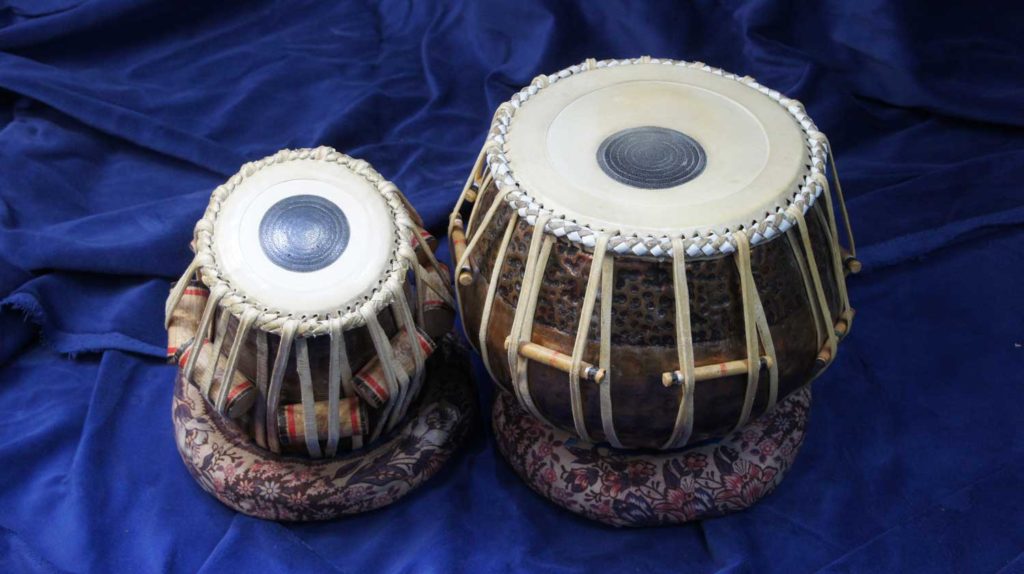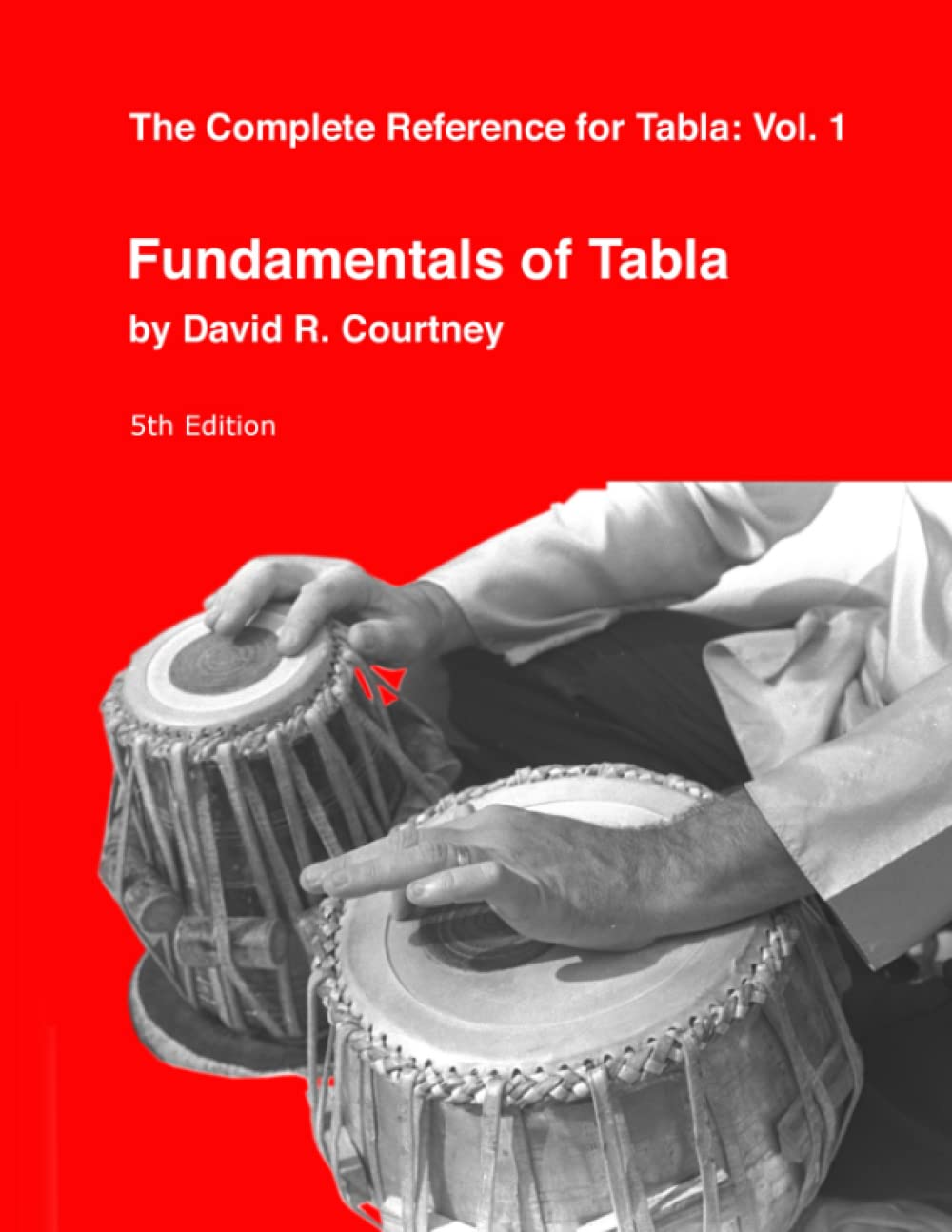
- Do I need a teacher?
- Where can I find a teacher?
- Where can I find a set of tablas?
- How much do tablas cost?
- Should I get a cheap pair, or should I go for a professional quality instrument?
- How long does a tabla last?
- I find addresses for music stores in India; can I order directly from there?
- I have talked with other students from different teachers and their technique is different. Who is correct?
- What is a gharana?
- How much should I spend on lessons?
- How much should I practice?
- Is progress continuous or discontinuous?
- I recently switched teachers. My new teacher is telling me that everything I learned is wrong. Now I am confused.
| IF YOU ARE INTERESTED IN TABLA, THIS BOOK IS FOR YOU |
|---|
This is the first volume of the most complete series on the tabla. Fundamentals of Tabla It is available around the world. Check your local Amazon for pricing. |
Do I need a teacher?
It is STRONGLY recommended. Basic things, such as tuning the tabla, are almost impossible to learn on your own. The technique may be learned to a limited degree by books, CDS, and videos, but there is still no substitute for a qualified teacher.
Where can I find a teacher?
A lot depends upon where you live. If you live in India, you should have no problem finding a teacher. If you live outside of India, it is sometimes difficult. Here are some steps that may help.
- Check the “Teachers / Performers Database”. This is an extensive list of musicians around the world. You can see if someone is listed in your area.
- Place a query in the “Indian Music Forums“. You can ask if someone on the forum knows of a good teacher in your area.
- Ask among friends. Perhaps one of your friends might know of a good teacher.
Where can I find a set of tabla?
Tablas may be purchased several ways. If you live in India, it is no problem to find a good pair. However, for those who live outside of India, this is sometimes difficult.
The situation can vary from country to country. Although purchasing directly from India may be the best approach for you, you may wish to query other people who live in your country. Engage in discussions with other people in your area at the percussion section of the Indian Music Forums. These may be found at https://chandrakantha.com/forums/?p=%3Fforum%3D611834.
How much do tablas cost?
The cost is variable. At the time of writing, the cost is roughly $200-$400 US dollars. If you live outside the US, you should check for local pricing.
Should I get a cheap pair or should I go for a professional quality instrument?
I advise getting a medium priced pair. Here are the reasons why.
The quality of the instrument must be high enough or you will have a hard time learning. Production of a correct tone is sometimes impossible on instruments that are substandard. Therefore, avoid buying a cheap pair.
However, if this is your first tabla, you are going to bugger it up. People just do not automatically know how to tune and care for their instrument. This is something that must be learned. Unfortunately, this usually means that you will damage the instrument due to mishandling. Don’t feel too bad about it, because this is all part of the learning process. Unless you have no qualms about spoiling a good pair of tabla, try not to get the most expensive pair.
The bottom line is that a medium grade tabla is a good choice for a beginner. It should be of high enough quality so that one can learn, but it should not be so expensive that if it is damaged you will feel bad.
How long does a tabla last?
I have run across instruments in India where people have told me “This tabla belonged to my Great-Grandfather”. What they are actually saying was that the wooden or metal shell belonged to their grandfather. The lacing and heads have been replaced many times.
The lifespan of the tabla is the period that starts when it is new and goes to the point where it costs more to repair than to buy a new one. Therefore, the lifespan is dependent on local economic conditions. In India, the shells may be reheaded and relaced indefinitely because there is a considerable amount of cost tied up in the shells themselves. Furthermore, labour for repairs is relatively cheap. Therefore in India, the lifespan of a tabla is indefinite.
Things are considerably different in the West. As a general rule, head replacements are an economical form of maintenance, but head replacement plus replacement of the lacing cost about what a new instrument will run. If you have a Bengali (Calcutta) style tabla, you can plan on replacing the head on average of once every 1-2 years of heavy use with an overall lifespan of 3-8 years. A standard tabla on the other hand, will give you 2-4 years between head replacements and have an overall lifespan of 8-16 years. These are just rough estimates. If you misuse your instrument you can break it on the first day. Conversely if you never tune it up and never play it, then it will last a long time.
The situation is altered tremendously if you take the time to learn how to replace the heads and lacing yourself. In such cases the shells may be used indefinitely. Your best bet is to pick up a copy of “Manufacture and Repair of Tabla” for the most information anywhere. This, coupled with the numerous YouTube videos, will get you started in learning how to do these things yourself.start
I find addresses for music stores in India, can I order directly from there?
I used to strongly recommend against this. There were too many things that could go wrong, and it was almost impossible to send it back if there was a problem. However over the last few years, the business culture in India has progressed where it is now possible. Research your dealer on the internet, and if they have a good reputation, you might consider it. Still ALWAYS EXERCISE GREAT CAUTION!
I have talked with other students from different teachers and their technique is different. Who is correct?
Most probably everyone is correct. There are different styles of playing. For example, a guitarist must show proficiency in various styles such as classical, rock, or flamenco, to be deemed a competent musician. In the same way it is essential that a tabla player have proficiency in the various styles. These styles are usually dependent on the gharana of their teachers. Typically a teacher will start teaching in one style, then later introduce other styles. However, there is no consensus as to which style will be taught first.
What is a Gharana?
Gharana was a system that developed in the last few centuries. It is essentially a school or approach to tabla. Travel used to be very difficult in India, so different geographical areas developed their own techniques.
Today the concept of gharana has become an impediment to musical training. The system tends to promote a feeling of “our gharana is the best”. Such a feeling, even when it is not verbalised, is crippling. I have seen many potentially good students who have been hamstrung because they either did not know, or did not care to use, the techniques that were developed from gharanas other than their own.
The different gharanas provide different sets of tools to the musician, yet no gharana has all of the tools. This situation was acceptable 100 years ago because audiences and musicians alike could not easily travel. You could function within a single style because your audiences were also unaware of other possibilities. Today things are different. Audiences have heard many musicians from many gharanas. If you only have the tools provided by one gharana, the audiences will sense your limitations, even if they are not knowledgeable enough to articulate it. A tabla player who only performs in the style of a single gharana is like a carpenter who only has one tool. Would you hire a carpenter who only had a saw, but no hammer or screwdriver?
How much should I spend on lessons?
This depends upon local conditions. Check your local music store and you will get an idea as to what is average for musical instruction in your area.
How much should I practice?
You should practice as much as possible without burning out.
It is sometimes difficult to know when you are at the burnout stage. We have all gone through periods where we were practising and making progress. At some point we feel some difficulty. It is normal to think that if we just practice some more, then we will get through the difficult period. Although sometimes this works, in many cases we find that we start to become tense and apprehensive. It is important to realise that when you reach this point, you have to just stop and walk away. Sometimes we must put our instrument away for days or even weeks. It all depends upon the level of burnout. When you return fresh, you will be surprised at how much easier things are then.
Is musical progress continuous or discontinuous?
Learning tabla, like learning any musical instrument, is very much a discontinuous process. There are periods where one makes good progress. At other times, it feels that we are not making any progress at all. This alternation continues indefinitely.
For one who has never learned a musical instrument, the first obstacle is the most critical. It usually occurs between 1-3 months. It is at this point that the initial enthusiasm has worn off and there is the aching realisation that learning tabla is not going to be quick and easy. This is when a very large number of students drop out.
If one realises ahead of time, that it is a long and difficult journey, and that the first block is just one of many, it often reduces the dropout rate. This “six week slump” is just one of many difficulties in the long road to learning tabla. Many students mistakenly interpret this first obstacle as an indication that they are unfit to learn tabla.
I recently switched teachers. My new teacher is telling me that everything I learned is wrong. Now I am confused.
Unfortunately this is a reflection of the musico-political sentiments that are part of the system. There is nothing wrong with starting over according to the new teacher’s particular style of teaching. Relearning the basics is necessary, both so that the teacher may have a clear idea of where you stand, as well as to make sure that there are no gaps in your background. But the common Indian habit of belittling the previous teacher is a great disservice. If you find yourself in this situation, just take all the statements with a grain of salt, and move on with your training.
